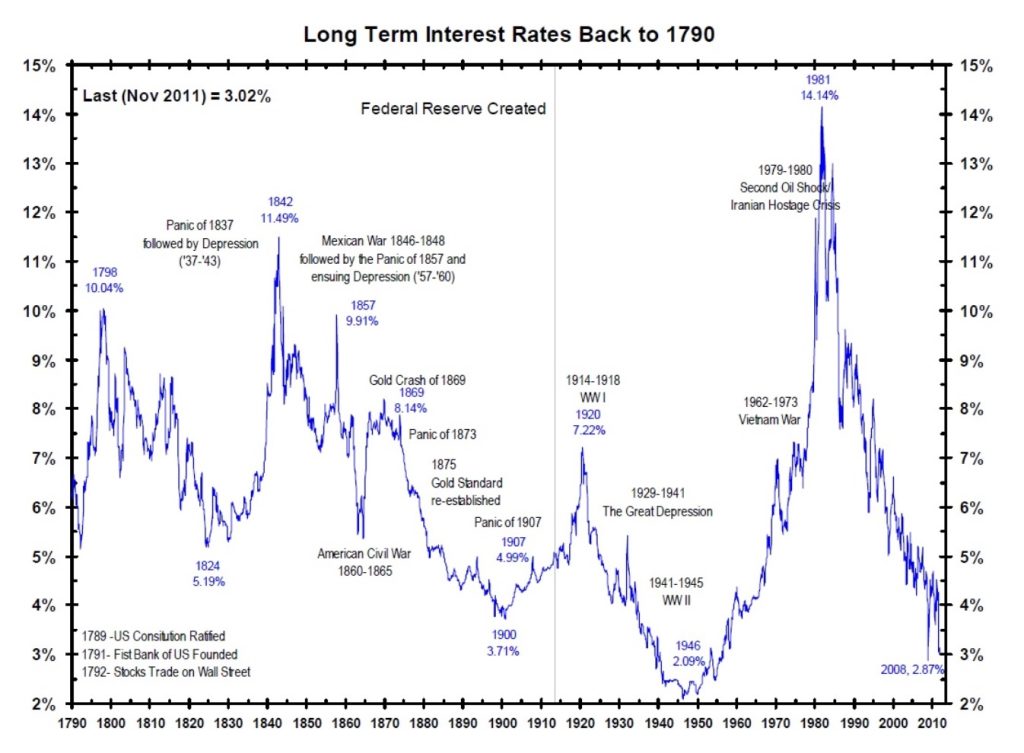Interest rates may increase due to certain economic activities or national policies. Below are some key activities that can lead to higher interest rates:
Increased Public Spending and Budget Deficit
- When the government increases spending (e.g., on infrastructure, defense, or social welfare) without a corresponding tax increase, it leads to a budget deficit.
- To cover this deficit, the government often borrows more money by issuing bonds.
- As borrowing demand increases, market interest rates may rise due to tighter capital supply.
Tax Reduction
- Tax cuts can reduce state budget revenue, leading the government to borrow more to compensate for public spending.
- This increases borrowing demand, pushing interest rates higher.
Tight Monetary Policy (Restricting Money Supply)
- The central bank may raise interest rates to control inflation or reduce consumption.
- When the base interest rate rises, financial institutions raise lending rates, increasing borrowing costs for businesses and individuals.
- The goal of this policy is to reduce demand in the economy and control inflation.
High Inflation
- When inflation rises sharply, the central bank often raises interest rates to curb demand and control inflation.
- High interest rates reduce the incentive to borrow and spend, thereby helping stabilize prices.
Strong Economic Recovery
- When the economy recovers and grows strongly, businesses and individuals’ demand for capital increases, leading to greater competition for loans.
- This can push interest rates up as capital supply struggles to meet higher demand.
Capital Outflows
- If investors transfer capital abroad to seek higher returns (due to low domestic interest rates or better investment opportunities overseas), net capital flows decrease.
- The central bank may raise interest rates to retain capital domestically, prevent the local currency from depreciating, and stabilize the economy.
Conclusion
Activities such as increased public spending, tax reductions, tight monetary policy, inflation control, and capital outflows can all lead to higher interest rates. These policies can help adjust the economy but often come with side effects such as reduced investment and consumption.
Activities such as increased public spending, tax reductions, tight monetary policy, inflation control, and capital outflows can all lead to higher interest rates. These policies can help adjust the economy but often come with side effects such as reduced investment and consumption.
Why Do Capital Outflows Cause Currency Depreciation? Isn’t It Just a Matter of Exchange Rate Conversion?
It is true that capital outflows involve currency conversion, but their impact on exchange rates (and, subsequently, the value of the local currency) goes beyond conversion alone and involves the supply and demand for foreign exchange in the market. Here’s a detailed explanation:
Supply and Demand for Foreign Exchange
- When investors or businesses withdraw capital from a country, they need to sell the local currency to exchange it for foreign currency (typically strong currencies like USD, EUR, or JPY) to transfer funds abroad.
- Selling the local currency to buy foreign currency increases the supply of the local currency in the market and raises demand for foreign currency.
- When the supply of the local currency increases while its demand decreases, its value tends to decline (depreciate) relative to other currencies.
Loss of Confidence and Disrupted Investment
- Capital outflows often signal a lack of investor confidence in the economy, concerns about risks, or a search for better returns abroad.
- When international investors and businesses see significant outflows, they may become worried about the country’s economic or political stability, leading to reduced direct or indirect investments in that country.
- This further reduces demand for the local currency, accelerating its depreciation.
Floating Exchange Rate Systems
- In floating exchange rate systems, exchange rates are primarily determined by supply and demand for foreign currencies in the market.
- When significant capital outflows occur, demand for foreign currency increases (for transferring funds abroad), pushing the value of foreign currencies higher compared to the local currency.
- Therefore, if net capital outflows are significant without sufficient inflows to offset them, the local currency will naturally depreciate in international markets.
Market Sentiment Impact
- The foreign exchange market is highly sensitive to changes in capital flows, as these represent shifts in confidence in an economy’s strength.
- When investors see capital leaving a country, they may anticipate the local currency’s depreciation, prompting them to sell the currency even more. This creates a downward spiral in the currency’s value.
Challenges for Central Banks
- When outflows are too large, the central bank must use foreign exchange reserves to stabilize exchange rates and maintain the local currency’s value.
- However, if foreign exchange reserves are insufficient, the central bank will struggle to control the exchange rate, leading to rapid depreciation of the local currency.
Conclusion
Capital outflows are not merely a matter of exchange rate conversion but also affect supply and demand in the foreign exchange market. Continuous net capital outflows decrease the local currency’s value because of increased demand to sell the local currency for foreign currency. Without effective intervention, prolonged outflows can lead to further depreciation of the local currency.
The value of the local currency and its regulation
The value of a local currency is determined by various factors, depending on the exchange rate policy of each country. There are three main systems for determining the value of a local currency:
Floating Exchange Rate:
- In a floating exchange rate system, the value of the local currency is determined based on supply and demand in the foreign exchange market.
- Investors, businesses, banks, and financial institutions trade foreign currency daily, creating price fluctuations.
- For example, if the demand for the local currency increases (due to investors wanting to invest in that country or due to rising exports), the value of the local currency will increase. Conversely, if many people sell the local currency to buy foreign currency (due to concerns about economic downturns or high inflation), the value of the local currency will decrease.
- In this system, the market is the main determinant of the currency’s value, and the central bank intervenes only when necessary to stabilize the market.
Fixed Exchange Rate:
- In a fixed exchange rate system, the value of the local currency is determined and maintained by the central bank at a fixed rate or within a narrow range against a stronger currency (usually USD or EUR).
- The central bank intervenes by buying or selling foreign currency reserves to maintain the set exchange rate.
- For example, if there is pressure causing the local currency to depreciate, the central bank will use foreign exchange reserves to buy back the local currency, increasing demand and maintaining its value.
- This system requires the central bank to have sufficient foreign currency reserves to intervene in the market when necessary.
Managed Float Exchange Rate:
- This system combines floating and fixed exchange rates.
- The currency value is still based on market supply and demand, but the central bank may intervene to prevent excessive fluctuations that could destabilize the economy.
- The central bank does not fix the exchange rate at a specific level but only intervenes when the value of the currency fluctuates beyond acceptable limits.
Conclusion
- In a floating exchange rate system, the market determines the value of the local currency.
- In a fixed exchange rate system, the value of the local currency is determined and controlled by the central bank.
- In a managed float exchange rate system, the currency value is primarily market-driven, but the central bank intervenes when necessary to maintain economic stability.
The choice of exchange rate system depends on the country’s economic goals, monetary policy, and the central bank’s level of foreign exchange reserves.
Intervention of Central Banks in the Foreign Exchange Market:
The intervention of central banks in the foreign exchange market using foreign reserves is generally not directly monitored by any specific international organization. However, there are indirect oversight mechanisms and reporting systems aimed at ensuring transparency and stability in global financial markets:
1. International Monetary Fund (IMF):
- The IMF is an international organization responsible for overseeing global financial stability. Member countries, including most nations worldwide, are required to report financial data, including foreign reserves and foreign exchange interventions, to the IMF.
- The IMF conducts periodic assessments (usually annually) through “Article IV Consultations” to evaluate each member country’s economic and policy conditions, including monetary and exchange rate policies.
- While the IMF cannot directly control or prevent interventions, it can issue recommendations and warnings about actions that might destabilize the economy.
2. Reporting and Information Disclosure:
- IMF member countries are encouraged to comply with the IMF’s Standard Data Dissemination Standards (SDDS) and General Data Dissemination System (GDDS), which require transparency regarding foreign reserves and monetary policies to ensure clarity and enable international organizations to assess risks.
- These reports provide global financial markets and institutions with clear insights into the foreign reserves status of each country, allowing them to evaluate its capacity for foreign exchange market intervention.
3. Bank for International Settlements (BIS):
- The BIS is an international institution that supports cooperation among central banks and is headquartered in Switzerland. BIS regularly publishes reports and organizes meetings between central banks to discuss global economic issues, including foreign exchange intervention policies.
- While BIS does not directly oversee foreign exchange interventions, it serves as a platform for information exchange and encourages measures to stabilize markets.
4. International Organizations and Economic Blocs:
- Certain economic blocs and alliances, such as the European Union (EU) or the Association of Southeast Asian Nations (ASEAN), may have specific transparency and financial supervision rules for member states.
- In the Eurozone, for example, the European Central Bank (ECB) controls monetary and foreign exchange policies for member states, and any foreign exchange market intervention must align with the ECB’s common policies.
5. Financial Markets and Credit Rating Agencies:
- Credit rating agencies like Moody’s, S&P, and Fitch closely monitor economic data and foreign reserves of nations to provide credit ratings.
- Countries aim to maintain good credit ratings to secure loans at lower interest rates, and they generally adhere to recommendations regarding transparency and disclosure of information related to foreign reserves and foreign exchange interventions.
Conclusion
There is no direct organization that mandates or supervises foreign exchange interventions by central banks. However, international mechanisms like the IMF and BIS require transparency and provide recommendations to maintain financial stability. Disclosure of data related to foreign reserves and foreign exchange interventions is usually voluntary, but countries often comply to maintain credibility and avoid losing the trust of global financial markets.

